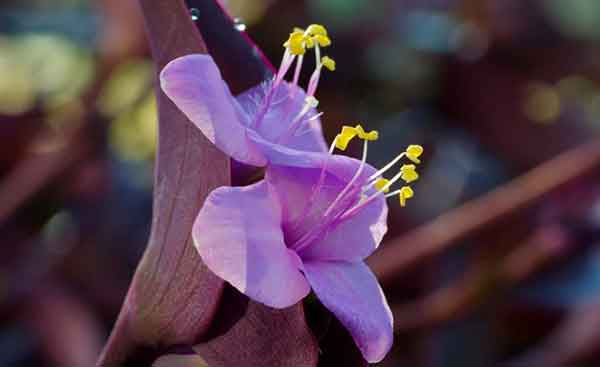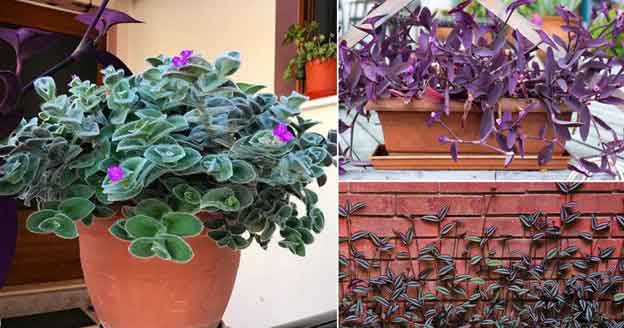Do you want to add the wandering jew plant to your home? – Whether in your home or your garden, wandering jet plants can play a big role in your life. Firstly, if you want to attract butterflies and other pollinators like hummingbirds and bees to your home or garden, you need to install Wandering Jew plants.

Moreover, these unique plants not only improve the quality of life but also improve your mental well-being. Apart from that, they make your surroundings beautiful.
In addition to that, when you are in the house, a wandering jew plant will help you purify the air by removing pollutants. Moreover, it also increases oxygen levels and regulates moisture. Hence, all these factors contribute to a healthy atmosphere.
What Is the Wandering Jew Plant?
The Wandering Jew Plant (Tradescantia zebrina) is a unique but popular houseplant. This is because it has colorful foliage, and it is easy to look after. Also, this plant helps you to alleviate stress, and improve your mood, and it helps you build a better bond with nature.
Apart from that, this plant will improve the aesthetics of your garden and your home with its big and unique leaves. So, if you want a Wandering Jew plant for your home or garden, visit Growcycle to get one. This way, you can work on sustainable living and create a sense of care for nature. In fact, many gardeners and homeowners use wandering jew plants to make their spaces more beautiful and refreshing.
Do Wandering Jews Attract Butterflies and Other Pollinators?
One of the most notable aspects of Wandering Jew plants is that they have flowers and a vibrant foliage. Hence, they are quite attractive to pollinators like butterflies, bees, and hummingbirds. So, if you want to attract butterflies and other pollinators to your home, install a Wandering Jew right now.

Basically, the plant’s flowers attract pollinators. This is because they are pale pink in color. Apart from that, the plant’s vibrant foliage along with its purple, green, and silvery colors add more to the plant’s aesthetics. Thereby, the plant is able to attract pollinators like butterflies, bees, hummingbirds, etc.
An Interesting Fact About Wandering Jew Plants…
Actually, the name “Wandering Jew Plant” has some concerns. This is because it links to an old story that is hurtful to Jewish people. Basically, the story goes back to medieval Europe, where a Jewish man was cursed to walk the Earth forever as a punishment. The plant was likely named for the way it spreads, but the name can still remind people of this painful history.
Hence, many people choose to call the plant by other names, like “Inch Plant,” “Spiderwort,” or simply by its botanical name, Tradescantia. Basically, these alternatives help to avoid the cultural and historical connotations. So, the focus is on highlighting the plant’s beauty and unique qualities.
The Wandering Jew Plant: Appearance and Characteristics
You can instantly identify the wandering jew plant by looking at its attractive leaves. However, depending on the type, the leaves often have a mix of green, purple, and silver stripes. Also, it has a shiny surface that makes any area beautiful.
In addition to that, its juicy stems feel soft, making it great for growing in pots or as garden ground cover. Apart from that, the wandering jew plant grows fast and adapts well. Hence, if you are starting out with gardening, this is a great plant to start with.
Additionally, the wandering jew plant blooms small flowers with three purple, white, or pink petals. This adds a subtle charm to their look. However, its flowers are not the main feature, but they still make the plant more decorative.
Different Types of Wandering Jew Plants
In general, there are several species and varieties of Tradescantia (Wandering Jew Plants) Here, each of them has unique characteristics:
- Tradescantia zebrina
Tradescantia zebrina is the most common variety of the wandering jew plant. Basically, its major features are the eye-catching purple and silver-striped leaves. Additionally, the undersides are often deep, rich purple, creating a beautiful contrast.
Hence, it is ideal for hanging baskets or decorative pots, where its trailing vines can shine. - Tradescantia fluminensis
The Tradescantia fluminensis has small and glossy-green leaves. Also, it is highly adaptable and often used as ground cover in gardens. On the other hand, it flourishes in shaded areas where other plants might struggle. - Tradescantia pallida
The Tradescantia pallida is a striking plant with bold, deep purple leaves which you will find quite attractive. However, unlike its trailing relatives, this variety grows more upright. This feature gives it a unique presence in any garden or indoor space. Moreover, it has longer and thinner leaves. This adds a delicate yet dramatic touch to mixed plantings. Apart from that, this drought-tolerant plant is a favorite among plant lovers. This is because it is adaptable, easy to maintain, and thrives both indoors and outdoors. - Tradescantia spathacea
The Tradescantia spathacea plant is known for its unique sword-shaped leaves with vibrant green tops and striking purple undersides. Also, it produces small, delicate white flowers from boat-shaped buds, earning it a charming nickname.
In addition to that, it comes with an eye-catching foliage and ornamental appeal. Hence, you can grow it as a potted plant or use it in landscaping to add color and texture.
Other Benefits of the Wandering Jew Plant in Your Home
In addition to its aesthetic appeal and its ability to attract pollinators, the Wandering Jew Plant has other benefits, namely:
- It Purifies the Air Inside Your Home
Generally, wandering Jew plants help you to clean the air inside your home. They absorb carbon dioxide and release oxygen. They also help you to remove some harmful chemicals, making the air fresher and healthier. - You Will Not Feel Stressed
When you have a Wandering Jew Plant in your home as well as greeneries around you, you will be able to reduce stress levels. This will improve your mood and increase your overall well-being. - It is Versatile and Adaptable
The Wandering Jew Plant’s adaptability suits various settings, including homes, offices, and gardens. Hence, you can also use it as ground cover, in hanging baskets, or mixed arrangements. - You Do Not Need to Do a Lot to Maintain It
These plants are highly durable and do not require a lot of maintenance. Hence, it is a great option for you if you stay busy or you do not have gardening experience. - You Can Propagate the Plant to Gift Others
The straightforward propagation process helps enable you to share cuttings with your friends and family. This way, you can spread the joy of gardening.
What You Need to Grow Wandering Jew Plant?
Basically, the wandering jew plant has the capability to flourish in various growing conditions. This is why it is a popular choice for indoor and outdoor spaces. The following are the ideal conditions where you will get better results if you grow the wandering jew plant: - Keep It in Indirect Light
Generally, the wandering jew plant likes indirect light, which helps it remain colorful. Also, it will be able to survive in low light. However, the leaves might lose their patterns and turn primarily green. Moreover, if you keep them outside, make sure to keep them in partial shade.
However, if you want to attract pollinators, do not keep them too much inside. Also, try to keep them in a place where humans cannot reach easily. In general, too much human contact repels pollinator. - Do Not Overwater the Plant
Wandering Jew plants prefer consistently moist soil, but overwatering can lead to root decay. Hence, always allow the upper layer of soil to dry between irrigations. Apart from that, when the water supply decreases, it grows slowly during the colder months. - Ensure the Right Temperature and Humidity
The Wandering Jew plant is native to tropical and subtropical regions. Hence, they generally grow in warm, humid environments. Therefore, the ideal temperature ranges from 60°F to 80°F. Although it can survive rare temperature drops, ensure to protect the plant from frost. - Use the Right Amount of Soil and Fertilizer
If you want to prevent waterlogging, keep them in a well-drained potted soil. Also, you can apply a general-purpose liquid fertilizer. You can apply this once a month during the growing period (spring and summer). This will help you to promote strong development.
However, avoid over-fertilizing, as it can lead to slow growth.
Frequently Asked Questions (FAQs)
The following are some of the common questions you will come across regarding wandering jew plants:
Do Wandering Jew Plants Attract Butterflies and Other Pollinators?
Yes, the Wandering Jew plant is capable of attracting pollinators like butterflies, bees, and hummingbirds. This is mainly due to the pale pink color of the plant and its vibrant and colorful foliage.
Does the Wandering Jew Plant Require Frequent Fertilization?
Although it does not require frequent fertilization, doing it once a month will give you good results. For instance, apply an adequately formulated liquid fertilizer once a month during the growing season. Meanwhile, make sure to delay fertilization during the colder months.
Is the Wandering Jew Plant Harmful to Pets?
Yes, wandering jew plants can cause harm to pets. If your cat or dog eat a part of your wandering jew plant, it might cause symptoms such as vomiting and skin irritation. Hence, keep the plant in such a place that your pets cannot reach easily.
Why Did the Leaves of the Wandering Jew Plant Lose Their Color?
In general, insufficient light is the biggest cause of fading colors in a wandering jew plant. Hence, ensure the plant receives bright, indirect sunlight. This way, they can produce vibrant shades.
Get a Wandering Jew Plant Now
Since the wandering jew plant is bright and you can take care of it easily, it is actually an excellent addition to your home or garden. Apart from that, if you want to attract pollinators, this plant is one of the best additions to consider. Also, many homeowners love it because it looks colorful and does not need much care.
In addition to that, this plant will also help you clean the air, add beauty to a space, and be fun to grow from cuttings. Moreover, it will increase the look of the indoor spaces and provide a fresh environment for the family. Hence, if you want to purchase this vibrant plant, visit Growcycle now.




